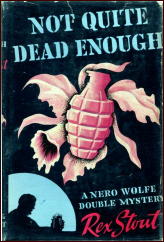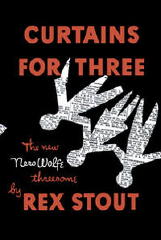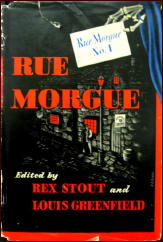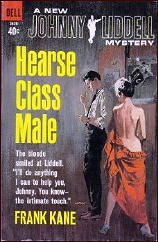Sun 8 Jun 2014
MIKE NEVINS on REX STOUT’s Nero Wolfe and FRANK KANE’s Johnny Liddell.
Posted by Steve under Columns , Reviews[10] Comments
by Francis M. Nevins
Last month I revisited a number of short novels — what the immortal Harry Stephen Keeler liked to call novellos, with the accent on the nov — but when I finished that column I felt like checking out a few more specimens and pulled down some volumes by Rex Stout, who at least among Americans was and still is the best known performer at that length.
Many decades ago I had read almost all the Nero Wolfe novels, long and short alike. In fact Wolfe’s last bow, A FAMILY AFFAIR (1975), was the first book I reviewed for the now long defunct St. Louis Globe-Democrat, and I still remember the book page editor adding a paragraph to tell readers that Stout had died, at age 88, between the time I’d sent in my review and the day it was published.
Rereading a couple of Wolfe’s shorter exploits recently, I enjoyed them as much as ever but found, as I’d noticed long ago, that Stout’s well-known habit of making up the plots as he went along often led him to paint himself into a corner. Take for example “Not Quite Dead Enough†(American Magazine, December 1942; collected in NOT QUITE DEAD ENOUGH, 1944).
This very early Wolfe novello takes place a few months after Pearl Harbor. Archie Goodwin, a newly minted major in Military Intelligence, is assigned to recruit his former boss, who would prefer to lose a pile of weight and join the infantry so he can kill Germans himself. Archie carries out his mission by framing himself for a murder and all but forcing Wolfe to clear him.
This time the sage of West 35th Street actually exposes the truth of the matter by something like deduction but, as he rightly points out at the wrap-up, the culprit’s scheme was “the silliest idea in the history of crime.†(Once Archie’s on-again-off-again girlfriend Lily Rowan tells the truth, as she’s bound to in due course, the only possible killer is the one who did the deed.)
In “The Twisted Scarf†(American Magazine, September 1950; collected in CURTAINS FOR THREE, 1950, as “Disguise for Murderâ€) the murder takes place in Wolfe’s own office on a day when he has allowed the members of the Manhattan Flower Club to invade the brownstone and admire his orchids.
The victim? A young woman who, shortly before her demise, took Archie aside and told him that while touring the plant rooms she had seen the person who had murdered a girlfriend of hers a few months earlier.
There’s much more physical action at the climax of this novello than one usually finds in Stout, and the murderer’s identity is a genuine surprise, but there wouldn’t have been a story at all except for the culprit having done something abominably stupid over which I shall draw a Salome’s veil except for those who opt to strip it off by clicking here.
I’m now going to change the subject. Well, not really.
Most mystery readers in my age bracket are likely to have read a few novels or stories by Frank Kane (1912-1968), the creator of PI Johnny Liddell. In his earliest appearances, which date back to around 1944, Liddell would probably have reminded most readers of Dashiell Hammett’s dumpy, overweight and streetwise protagonist The Continental Op.
One of those early tales was “Suicide†(Crack Detective Stories, January 1945), in which Liddell tries to prove that a man who apparently killed himself by eating his gun was actually murdered. This story wasn’t in either of Kane’s short story collections (JOHNNY LIDDELL’S MORGUE, 1956, and STACKED DECK, 1960) but was included in that now rare anthology RUE MORGUE NO. 1 (1946).
Who edited that anthology? Rex Stout and a guy named Louis Greenfield. How is that relevant here? Because the gimmick from “Suicide†pops up three years later in the Nero Wolfe novello “The Gun with Wings†(American Magazine, December 1949; collected in CURTAINS FOR THREE, 1950).
Didn’t I say I wasn’t really going to change the subject? It seems that when Stout didn’t make up his plots as he went along he took them where he found them.
Soon after Mickey Spillane and his sadistic sleuth Mike Hammer appeared on the scene and quickly transformed PI fiction — whether for better or worse is a matter of taste — Frank Kane decided to reconfigure Johnny Liddell into something of a Hammer clone, younger and better-looking and tougher and sexier than in his original incarnation, albeit without the carnage and psychotic rants that were the early Spillane’s trademarks.
The Liddell books do have their fans but for my money, if ever there were a truly generic PI series this is it. The writing is flat, the plots and characters from stock, the various adventures so interchangeable that Kane thought nothing of recycling whole passages from one Liddell novel into another. (Wasn’t it Marv Lachman who first discovered this?)
How fitting that late in the Fifties, when the first Mike Hammer TV series was launched, one of the first writers tapped to crank out scripts for it was Kane.
Ah yes, the first Mike Hammer TV series. I don’t believe I’ve ever written it up before so it just might make a nice subject for next month’s column. Don’t touch that dial!




June 8th, 2014 at 6:14 pm
I’ll be interested in reading your comments on the first Mike Hammer TV series. I’ve seen many of them and I like Darren McGavin’s wise cracking approach to crime. Of course he really didn’t play Mike Hammer as written by Spillane.
I believe I have all the Nero Wolfe books in paperback, including the novellas. AMERICAN MAGAZINE published 15 Nero Wolfe novellas I believe before they went out of business in the late 1950’s. I’ve heard they paid really high rates per word and I guess that’s why Rex Stout gave them first look at the novellas.
June 8th, 2014 at 7:22 pm
You can read Marv Lachman’s comments on the Johnny Liddell books here:
https://mysteryfile.com/blog/?p=684
Of all the authors of the Golden Age of Detection, it is of course Agatha Christie who’s remembered and still read today, but I think Rex Stout may be second — even though most likely not for the detection, but the overall ambiance, including the friendship and byplay between Nero Wolfe and Archie.
June 8th, 2014 at 7:24 pm
Walker
There’s no chance that in the late 50s they could have put on TV anything like the real Mike Hammer stories. The McGavin series makes for pleasant watching, but without the Mike Hammer name, he’d be just another generic PI.
June 8th, 2014 at 7:48 pm
I agree and disagree with Brother Nevins on the Liddell series. Yes, Liddell is generic and the series runs out of steam way too soon due to those self-plagarism issues cited. But the early ones are pretty good (Bullet Proof, Dead Weight, Poisons Unknown) and his filmed standalone, Key Witness, is very good. The trick to reading those and the other better Liddell novels is to pretend that it’s the only Liddell book Kane ever wrote. He has a nice, cinematic sense of pacing and framing his scenes. And I’ve always thought of the McGavin Hammer show as “Frank Kane’s Johnny Liddell.” I believe Kane wrote more scripts for the show than anyone else, and every one of his is based on Liddell short stories that appeared in Manhunt, etc. I once asked Mickey Spillane if he was aware of this. He snorted derisively and said, “Yeah. And when I found out, I had ’em fire the a**hole.” There’s a real nice writeup on Frank Kane over at the Thrilling Detective website. Oh, and Kane got back at the TV show that bounced him with his Liddell novel, The Mourning After, all about the backstage doings on a Mike Hammer-style TV show.
June 8th, 2014 at 9:44 pm
Honestly I can’t remember who did it — other than J. Edgar Hoover and Arnold Zeck — in a single Wolfe novel, but I read them for Wolfe and Archie, the cast, the setting, and seeing how Stout would get Wolfe to do something he normally wouldn’t — like dressing up like Santa or leaving the brownstone. I love them, but not really for who done it so much as what’s going to happen while we wait to find out.
I like the better early Liddell books, and have some affection for the generic later ones. To me they killed a half hour to forty five minutes pleasantly, Kane drew some sexy ladies, and the result was a bit like many of the pi series on television in the 50’s and 60’s. They were cheap to buy, quick to read, had nice Harry Schaare covers, and I could polish one off waiting to see the dentist or doctor or in quick snatches between classes.
Like everyone else looking forward to the article on the McGavin Hammer series. I remember these fondly, they were my first exposure to Hammer and Spillane, there was great music, and though I haven’t seen but one episode since the sixties (the pilot) I still recall some of the plots including one about a student killed in a hazing incident. That’s actually more than I can say for episodes of the Keach series other than the two hour movies.
June 8th, 2014 at 10:20 pm
Just a couple of quick comments, I’ve long held the best format for the detective story was the novella and for me those are often the best of Stout’s output with Wolfe. I don’t dislike the novels, and some are outstanding, but I still hold the novella’s are generally superior technically.
Love or hate Spillane, without him we likely would not have had Gold Medal, John D. MacDonald’s more adult novels, Prather’s near surrealistic Shell Scott, Westlake/Stark’s Parker, Spenser, or most of Max Allan Collins, so the influence on the genre was ultimately positive, and I would suggest he gave the entire genre a post war boost that it needed vitally. Even the reaction against him produced some good writers and series, and without him we would never have had Peter Gunn on television.
And since many of the major prewar writers continued successfully post Spillane. I think he was inevitable after the violence and social change of the war, less a creator of a national mood than a bellweather.
June 8th, 2014 at 11:23 pm
The relationship between Archie and Nero Wolfe is what makes the series so readable and enjoyable. Reading some of the Nero Wolfe books got me through a difficult period of my life.
After graduating from college, I was almost immediately drafted in 1966. I took basic and advanced infantry training during the winter of 1966-1967 and it seemed that I spent the entire time outside and in the snow. I was hospitalized on 5 occasions with fevers and during my stays in the hospital I read several of the Nero Wolfe novels.
It seemed like heaven to be in bed, away from army training, and reading the novels. A real example of escape literature!
June 9th, 2014 at 3:12 am
Interesting observations there on the Stout/Kane relationship–if you can call stealing someone’s idea a “relationship.” My problem is tat I always confuse Frank Kane with Henry Kane–who did some nice stuff!
June 9th, 2014 at 7:43 am
That’s a problem I have, too, Dan. When I first posted Mike’s column, I had as the title “Mike Nevins on REX STOUT’s Nero Wolfe and HENRY KANE’s Johnny Liddell.”
I didn’t catch this until 10 or 15 minutes later.
June 9th, 2014 at 4:39 pm
The only way I keep the Kane’s apart is because Frank was actually a Boyd, though Henry was a much better and more interesting writer.
Ironic that some of the late Liddell’s were published by a soft porn publisher just as some of the late Peter Chambers were before Henry made his comeback with the McGreggor books.